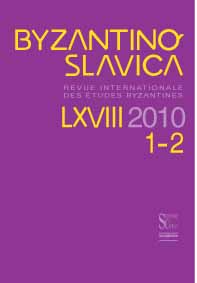Western influences on 17th-century post-Byzantine wall paintings in the Peloponnese: Roots in the 16th century
Western influences on 17th-century post-Byzantine wall paintings in the Peloponnese: Roots in the 16th century
Author(s): Xanthi ProestakiSubject(s): History
Published by: AV ČR - Akademie věd České republiky - Slovanský ústav and Euroslavica
Summary/Abstract: 17th-century wall painting in the Peloponnese shows the trends visible in painting in the two great currents of the 16th century, that of the Cretan school and the school of NW Greece. The influx of Western iconographic elements – whether in the overall pattern, as in the scenes of the Massacre of the Innocents, the Crucifixion and the Noli me tangere, or in details – it is done very discreetly and assimilated into the aesthetic of the Byzantine tradition. Western motifs exert no more than an indirect influence on the style of their work. Despite the teachings of the great creators of wall paintings in the 16th century, Frangos Katelanos and Theophanes, and their sensitisation to humanism and Renaissance art, the Peloponnesian artists of the 17th century, the Kakavas and Moschos families and Manuel Andronos, proved to be more conservative and remained loyal to the aesthetic of the Byzantine tradition. Western elements infiltrated their work through the innovations of 16th-century painting. In isolated cases only, such as the Philosophou Monastery, new themes and motifs were introduced that showed the influence of painters of portable icons, whose clients included both the Catholic and Greek Orthodox bourgeoisie, whose good taste and way of life were influenced to a large degree by the ideas of the Renaissance. The innovations introduced in 17th-century wall paintings in the Peloponnese through the great works of the 16th century constitute examples of an art that is trying to renew itself while remaining faithful to its roots and to its doctrinal content. In this way, the co-existence of various elements of folk origin from daily life can be explained, as artists showed particular interest in the world around them and drew many details from it, objects of daily use, clothing, etc. Despite its conservative nature, 17th-century painting in the Peloponnese succeeded in responding to its era. It is an art which, in terms of its iconographic content, belongs to its times, taking on elements even indirectly from Western art, creating eclecticist agglomerations of features of daily life, and in this way reflecting the thought processes of a subjugated people who were trying to survive by preserving their traditions.
Journal: Byzantinoslavica - Revue internationale des Etudes Byzantines
- Issue Year: LXVIII/2010
- Issue No: 1-2
- Page Range: 291-352
- Page Count: 62
- Language: English
- Content File-PDF

